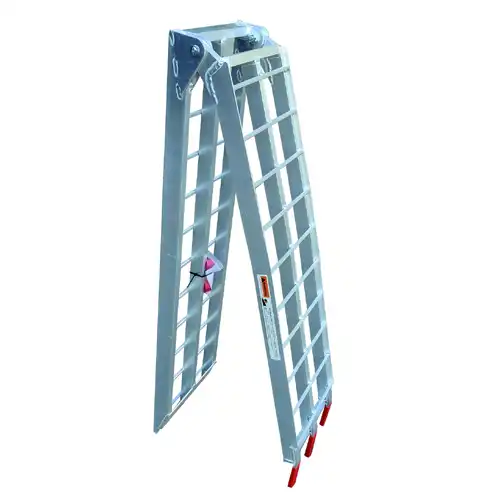The Importance of Motorcycle Ramps in Professional Settings
Enhancing Safety and Efficiency
In professional repair shops and maintenance garages, safety is paramount. Motorcycle ramps play a crucial role in minimizing risks associated with lifting and maneuvering heavy bikes. By providing a stable and gradual incline, these ramps allow technicians to easily roll motorcycles onto elevated platforms or work stands without the need for strenuous lifting. This not only reduces the likelihood of workplace injuries but also preserves the integrity of the motorcycle's components during the elevation process.
Versatility in Application
The versatility of motorcycle ramps extends beyond simple elevation. Many modern ramps are designed with adjustable features, allowing technicians to accommodate various motorcycle sizes and styles. From sportbikes to touring cruisers, a well-designed moto ramp can handle a wide range of vehicles, making it an invaluable asset in any repair shop. Some advanced models even incorporate built-in wheel chocks and tie-down points, further enhancing stability and security during maintenance procedures.
Time and Space Efficiency
In bustling repair shops where space is at a premium, motorcycle loading ramps offer a space-saving solution. Unlike bulky hydraulic lifts, these ramps can be easily stored when not in use, maximizing the available floor space for other tasks. Additionally, the quick setup and dismantling of ramps contribute to improved workflow efficiency, allowing technicians to swiftly transition between different motorcycles and maintenance tasks throughout the day.
Choosing the Right Motorcycle Ramp for Your Garage
Material Considerations
When selecting a motorcycle ramp for professional use, the material is a critical factor to consider. High-quality aluminum ramps offer an ideal balance of strength and lightweight properties, making them easy to maneuver while capable of supporting heavy motorcycles. Some manufacturers incorporate reinforced designs or use aircraft-grade aluminum to enhance durability and load-bearing capacity, ensuring long-term reliability in high-traffic repair environments.
Load Capacity and Dimensions
Assessing the load capacity of a motorcycle ramp is essential for ensuring safe operation. Professional-grade ramps typically feature higher weight limits to accommodate a wide range of motorcycles, from lightweight sport bikes to hefty touring models. Additionally, the length and width of the ramp play crucial roles in determining its suitability for different motorcycle types and garage layouts. Longer ramps provide a gentler incline, which is particularly beneficial for low-clearance motorcycles or when dealing with heavier bikes.
Surface Texture and Traction
The surface texture of a motorcycle ramp significantly impacts its safety and usability. High-quality ramps often feature serrated or cross-hatched surfaces that provide excellent traction, even in wet conditions. Some advanced models incorporate rubberized coatings or textured paint finishes to further enhance grip. For repair shops dealing with a variety of motorcycles, including those with different tire types and tread patterns, selecting a ramp with optimal surface texture ensures consistent performance and safety across all maintenance scenarios.
Maximizing Efficiency with Motorcycle Ramps in Repair Workflows
Integrating Ramps into Diagnostic Processes
Motorcycle ramps can be strategically integrated into diagnostic workflows to enhance efficiency. By positioning ramps near diagnostic equipment, technicians can seamlessly transition from initial inspections to detailed examinations without the need for multiple lifting operations. This streamlined approach not only saves time but also reduces the risk of accidental damage during repeated handling. Some repair shops have even designed custom workflow layouts that incorporate permanent ramp installations, creating dedicated diagnosis zones that optimize space utilization and improve overall service speed.
Maintenance and Care of Motorcycle Ramps
To ensure longevity and consistent performance, proper maintenance of motorcycle loading ramp is essential in professional settings. Regular inspections for wear, corrosion, or structural damage should be conducted, particularly in high-volume repair shops. Cleaning the ramp surfaces to remove oil, grease, or debris helps maintain optimal traction and prevents slippage. Some technicians apply specialized coatings or treatments to aluminum ramps to enhance their resistance to environmental factors and chemical exposure, further extending their operational lifespan.
Training and Best Practices
Implementing comprehensive training programs for technicians on the proper use of motorcycle ramps is crucial for maximizing their benefits while ensuring workplace safety. This includes instruction on correct loading techniques, weight distribution principles, and the importance of using additional safety measures such as wheel chocks or tie-downs. Establishing clear protocols for ramp usage, including regular safety checks and proper storage procedures, helps maintain a high standard of professionalism and efficiency in repair shop operations.
Conclusion
Motorcycle ramps have become indispensable tools in professional repair shops and maintenance garages, offering a blend of safety, efficiency, and versatility. From enhancing workplace ergonomics to streamlining diagnostic processes, these ramps play a pivotal role in modern motorcycle maintenance. By carefully selecting the right ramp, integrating it effectively into workflows, and maintaining it properly, repair shops can significantly boost their operational efficiency and service quality. As the motorcycle industry continues to evolve, the importance of reliable, high-quality ramps in professional settings is set to grow even further.
Contact Us
Ready to elevate your repair shop's efficiency with top-quality motorcycle ramps? Contact RUNVA ENTERPRISES LIMITED at info@runva.com.cn for expert advice and cutting-edge solutions tailored to your professional needs.

_1737625693698.webp)


